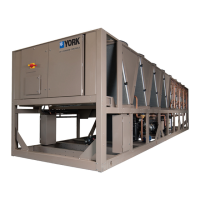JOHNSON CONTROLS
35
Form 201.28-NM1.1
Issue date: 08/06/2021
4
Section 4 - Installation
Location requirements
For optimum performance and trouble-free service, it
is essential that the installation site meet the location
and space requirements for the model being installed.
It is important to ensure that the minimum service
access space is maintained for cleaning and mainte-
nance purposes.
Outdoor installations
The units are designed for outdoor installation and
can be installed at ground level on a suitable flat level
foundation easily capable of supporting the weight of
the unit, or on a suitable rooftop location. In both cases
an adequate supply of air is required. Avoid locations
where the sound output and air discharge from the unit
may be objectionable.
The location should be selected for minimum sun
exposure and away from boiler flues and other sources
of airborne chemicals that could attack the condenser
coils and steel parts of the unit.
If located in an area accessible to unauthorized per-
sons, steps must be taken to prevent access to the
unit by means of a protective fence. This will help to
prevent the possibility of vandalism, accidental dam-
age, or possible harm caused by unauthorized removal
of protective guards or opening panels to expose rotat-
ing or high voltage components.
For ground level locations, the unit must be installed
on a suitable flat and level concrete base that extends
to fully support the two side channels of the unit
base frame. A one-piece concrete slab, with footings
extending below the frost line is recommended.
To avoid noise and vibration transmission, the unit
should not be secured to the building foundation.
On rooftop locations, choose a place with adequate
structural strength to safely support the entire operating
weight of the unit and service personnel. The unit can
be mounted on a concrete slab, similar to ground floor
locations, or on steel channels of suitable strength. The
channels should be spaced with the same centers as the
unit side and front base rails. This will allow vibration
isolators to be fitted if required. Isolators are recom-
mended for rooftop locations.
Mounting holes (5/8 in.) are provided in the base rails
for bolting the unit to its foundation. See Table 10 on
page 84 for location of the mounting holes.
Any ductwork or attenuators fitted to the unit must not
have a total static pressure resistance, at full unit air-
flow, exceeding the capability of the fans installed in
the unit.
The condenser fans are propeller-type and are not
recommended for use with ductwork, filters or other
impediments to airflow in the condenser air stream.
When it is desirable to surround the units in
addition to the optional louver package selected, it is
recommended that the screening passes the required
chiller CFM without exceeding 0.1 w.g. (24.9084 Pa)
external static pressure.
Protection against corrosive environments is avail-
able by ordering the units with cured epoxy-coating on
the microchannel condenser coil. Epoxy-coated coils
should be used with any units being installed at the sea-
shore where salt spray/mist may hit the units, or where
acid rain is prevalent.
On installations where winter operation is intended and
snow accumulations are expected, additional elevation
must be provided to ensure normal condenser air flow.
Avoid locations near windows or structures where
normal operating sounds may be objectionable.
Location clearances
Adequate clearances around the units are required for
the unrestricted airflow for the air-cooled condenser
coils and to prevent re-circulation of warm discharge
air back onto the coils. If clearances given are not
maintained, airflow restriction or re-circulation will
cause a loss of unit performance, an increase in power
consumption, and may cause the unit to malfunction.
Consideration should also be given to the possibility of
down drafts, caused by adjacent buildings, which may
cause re-circulation or uneven unit airflow.
For locations where significant cross winds are expect-
ed, such as exposed roof tops, an enclosure of solid
or louver type is recommended to prevent wind turbu-
lence interfering with the unit airflow.
When units are installed in an enclosure, the enclosure
height should not exceed the height of the unit on more
than one side. If the enclosure is of louvered construc-
tion, the same requirement of static pressure loss ap-
plies as for ducts and attenuators stated above.

